Unveiling insights: Exploring the narratives of women in the Serbian ICT Industry
April 17, 2024
As every researcher knows, there is always the question of whether the plural of “anecdote” is “data”. While there is no simple answer, our work with girls and women in the Serbian ICT industry, and the application of the design thinking approach that underpins the work of UNDP Accelerator Lab, led us to apply the “journey maps” model to find commonalities between numerous stories of girls and women entering (and exiting) the Serbian ICT industry through different pathways, to see how their status could be improved.
There were two key motivations for this work. Although Serbia does well compared to European and global statistics in terms of women’s participation in the industry, women are still underrepresented.
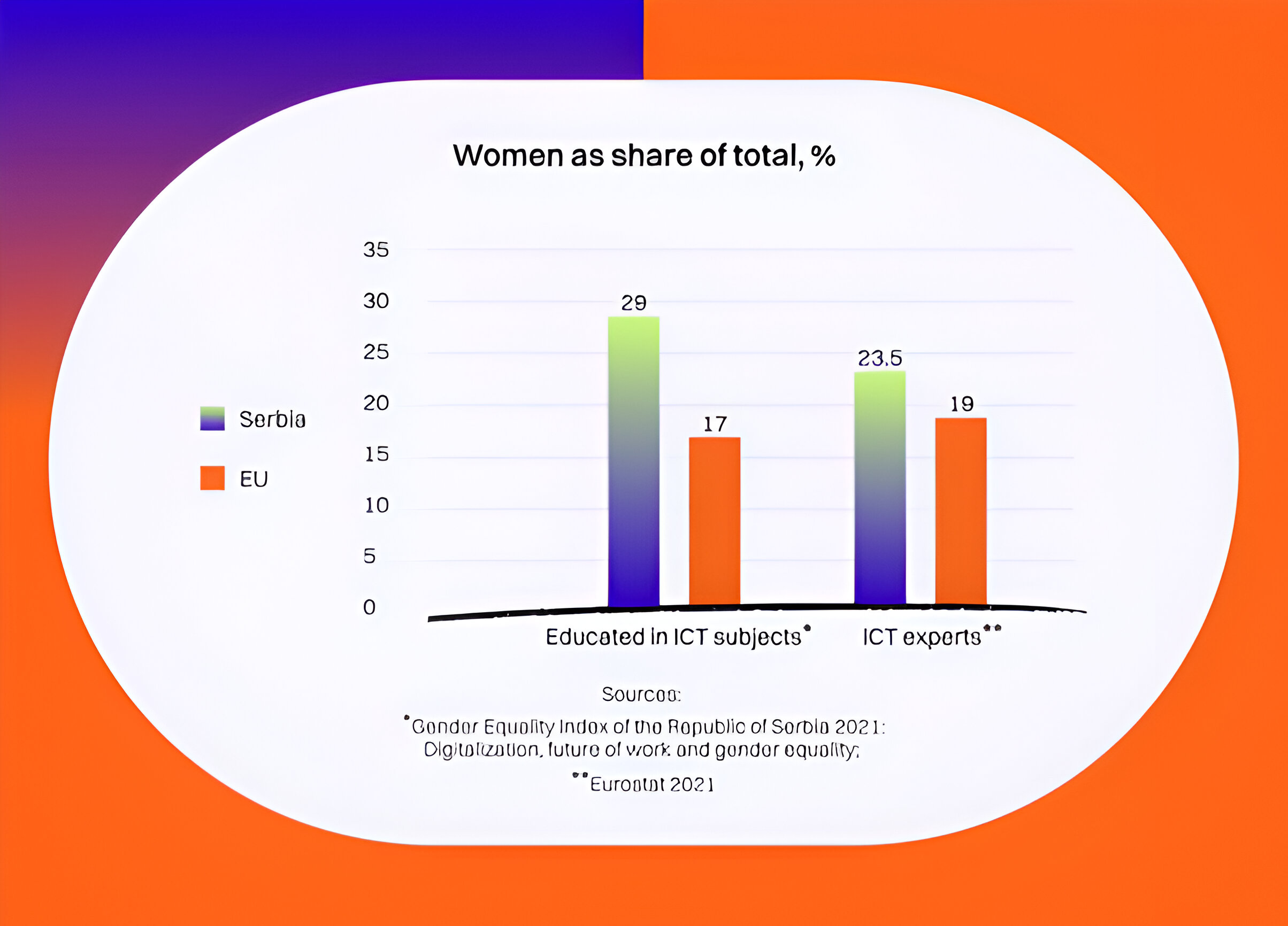
In addition, women are still severely underrepresented in managerial and ownership positions in the Serbian ICT industry, which is related to the following two global phenomena:
“leaky pipeline” - women leaving the industry before advancing to higher positions;
“broken rung” - where women experience additional headwinds in managerial positions
These two issues mean that women are both underrepresented in a growing, well-paid industry, which affects their economic and social stance, but also that they are less able to influence the development of new technologies and to highlight potential biases.
What did the user journey maps tell us?
Whether it was staying too long in a lower-paid position in their first job or not applying for jobs in the ICT industry because they considered themselves under-qualified, the 34 women we interviewed shared many common experiences that we had not previously considered prevalent and that we would not be able to pick up on in the quantitative research. Some other examples were the importance of early encouragement at school to choose STEM subjects and later, the existence of role models and appropriate corporate culture to retain women in ICT.
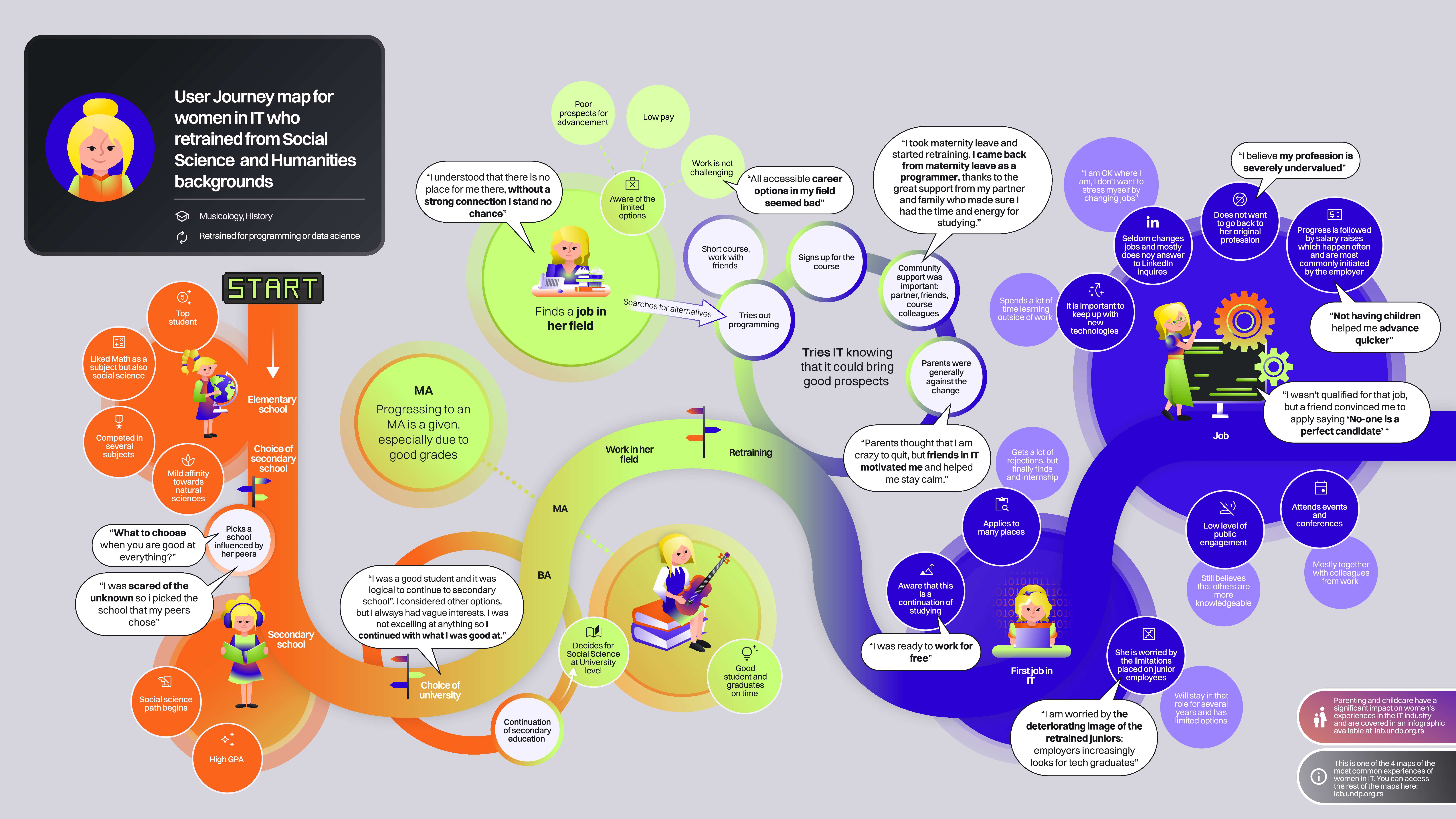
User Journey map for women in IT who retrained from Social Science and Humanities backgrounds. Credit and copyright: UNDP Accelerator Lab in Serbia
Many of the insights we gathered are actionable and can help companies and other institutions amend their practices to be better suited for retaining and developing female talent. Many of them would be difficult to gain for individual companies and institutions because employees are reluctant to speak openly to their employers about their experiences, or because the number of girls and women within some of them is too low to make them realize the commonalities of their experiences.
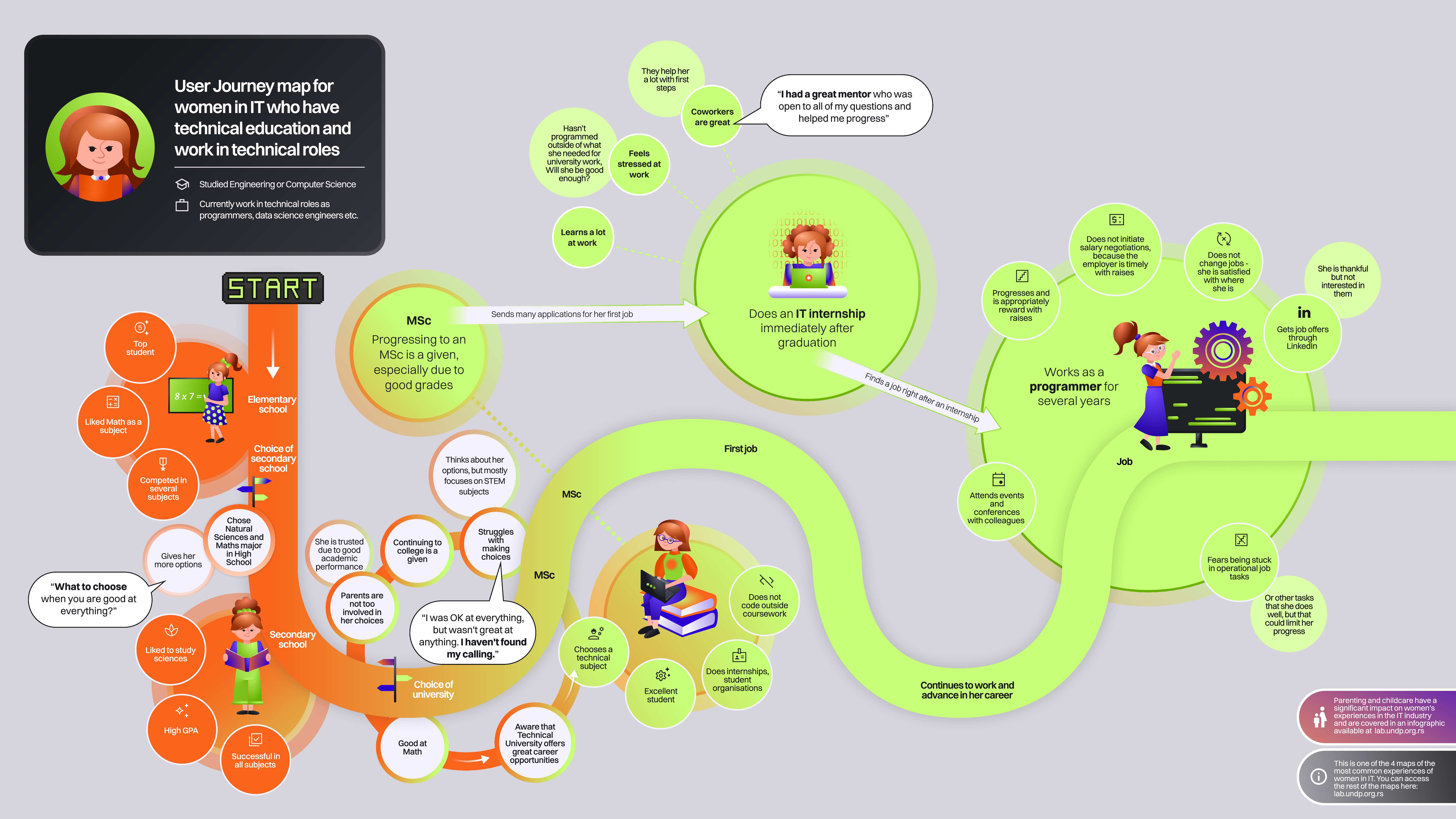
User Journey map for women in IT who have technical education and work in technical roles. Credit and copyright: UNDP Accelerator Lab in Serbia
For instance, the user journeys revealed that women are very reluctant to attend industry events that take up time reserved for their families, especially if they have children. Another such finding is the communication about the demands of ICT jobs, especially in more senior positions. Many women we interviewed, even those with STEM backgrounds, underestimated their skills for the first job, where more frank job postings and greater visibility of female colleagues could help attract women to apply and accept positions. In addition, our research found that women in ICT jobs tend to take on more behind-the-scenes organizational roles that contribute to the company but don’t necessarily lead to promotions and pay rises, leaving them feeling undervalued.
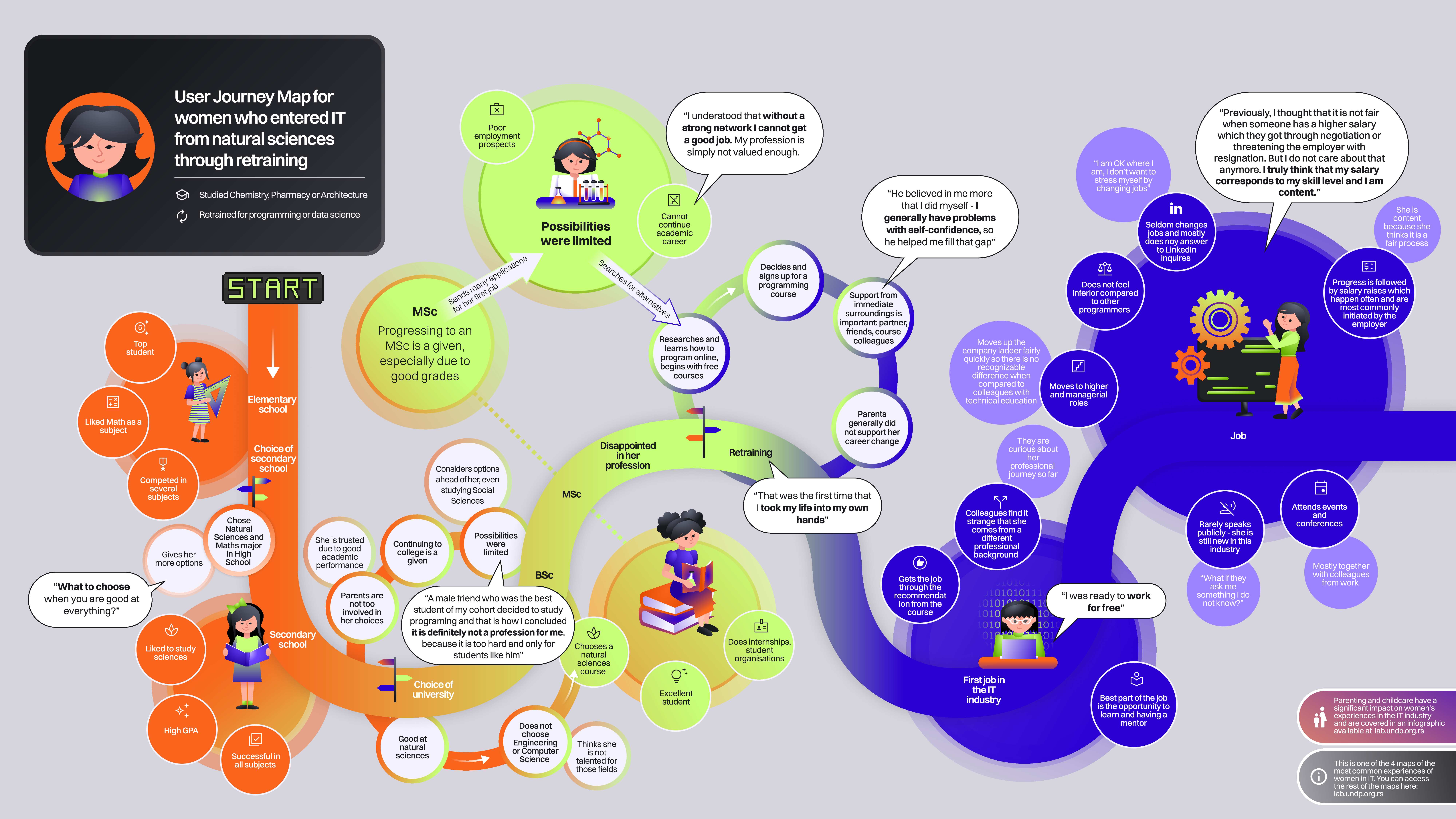
User Journey Map for women who entered IT from natural sciences through retraining. Credit and copyright: UNDP Accelerator Lab in Serbia
Exploring how the user journey methodology maps an entire life
Path mapping is not foreign to anyone involved in the development of a product or service and, above all, looking for ways to improve it.
It is a methodological approach that enables synthesizing large amounts of data in a self-reflective way that puts people and their needs at the center. It is with this method that we should look at the career path of women in the ICT industry, their motivation and support systems, as well as the barriers to entry and advancement.
User experience mapping, as a specific qualitative method, will shed light on the key positive and negative experiences of girls and women in the ICT industry that are not visible through the existing data. In our case, the main challenge was to find a pathway that could be followed over a longer period - namely an entire educational and professional life.
We opted for this method for the following reasons:
To gain a better and deeper understanding of the main breaking points and to target specific areas for intervention
To get a tool that tells a story and is, therefore, easier to remember, and can more easily motivate targeted interventions in subsequent planning and communication
To foster a sense of connection and togetherness between women in ICT by observing common characteristics
Although we initially thought of a more conceptual approach, after the interviews we decided to segment the maps according to life stages: Elementary School, High School, University, and Work. We also saw that decisions are made between these stages, e.g. when choosing a high school, choosing a college and looking for a job. Some other profiles also included a period of retraining or a period of leaving a technical position.
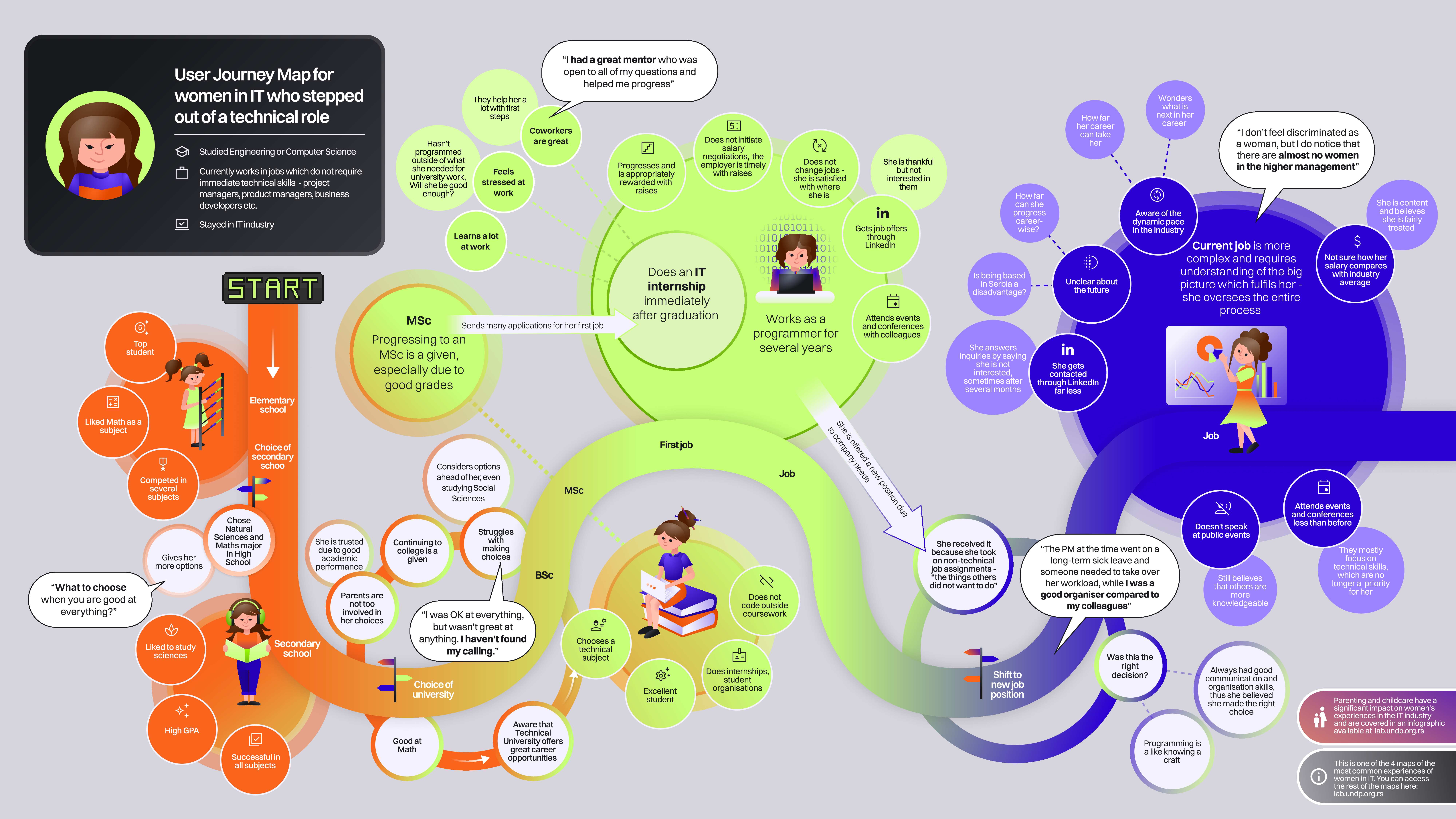
User Journey Map for women in IT who stepped out of a technical role. Credit and copyright: UNDP Accelerator Lab in Serbia
How to find representative people to tell their stories?
The main challenge was to ensure that the sample was as representative as possible, and this was the focus of most of the methodology.
The data on Serbian ICT that would help us ensure representativeness and to segment user journeys by the way they entered the ICT industry and their seniority was missing, so we had to resort to a larger sample to guide our work.
We decided to approach our interviewees through referrals from our own relatively broad network as we thought that “cold calling” via LinkedIn and similar networks would not yield results. We also took special care to interview enough “invisible” women: those who do not appear at events and do not keep a high profile, as they make up most of the local female workforce in ICT.
We had a problem finding out the family circumstances of the profiles we wanted to interview, as in more than half of the cases, they were not known to those who had referred the persons to us. We overcame this challenge by conducting iterative interviewing to determine the profiles we were missing.
In the end, it turned out that we selected several interviewees through personal contacts because we needed additional specific profiles to verify certain parameters and conclusions. This also led to a higher number of those interviewed than we had planned.
While we initially planned to conduct a few individual interviews first and then group interviews, we changed our approach. Namely, through an iterative approach to interviewing, we determined that a lot of value and data would be lost in a group interview. The women spoke openly about their fears and insecurities during the interviews, and we were concerned whether they would do the same in a larger group with unknown women. Therefore, it was decided that all interviews should be conducted individually. In the interviews, the women spoke really openly, and we believe that several factors contributed to this:
Confidentiality and data protection was ensured, as only the researcher had the list of women who were interviewed, as well as the notes of the interviews, and no one else. We also promised that nothing would be shared as an individual story. Although it initially seemed that this was not important to the women, we believe that they were more open when it came to sensitive topics, such as their relationship with their employer or their salary.
The conversations were not recorded, which further contributed to confidentiality.
The interviews were done one-on-one, so only one person was interviewed and only one person asked the questions. There was no one on the sidelines taking notes or asking questions.
We kept the questions about childhood and elementary and high school in all interviews because we found that they significantly relax a person and contribute to honesty.
Once the maps were created, we turned to data validation through research analysis for each segment on a global level. Interestingly, the global data we found almost always matched our conclusions, which strengthened our belief that we had created truly relevant maps that would fulfill our pre-set goals. In parallel, this validation helped increase the motivation for defining recommendations.
Where do we hope the user journey approach will lead us?
Even though the user journey approach is far from a silver bullet and needs to be complemented by other, less labor-intensive research approaches, we can see that it can lead to a more targeted approach to addressing women’s needs. As already mentioned, it provides actionable insights, whether it’s moving work-related networking events to office hours to ease the burden on mothers, providing services to make it easier for them to attend, or ensuring that prospective female employees are made aware of women in companies and institutions.
Through our work, we also realized that there is a need to create forums where women can speak openly about the issues they face. At one such event, where UNDP Serbia Accelerator Lab presented its “Women in Serbia’s ICT” report, there were breakout sessions on specific topics, such as the pay gap, motherhood and work, and women from the industry shared their stories about challenges as well as solutions. Another such initiative could be a stronger media presence of women from the industry, where they could both appear as role models and highlight issues they faced, and how they overcame them.
If you are interested in sharing your experiences related to overcoming the issues faced by women in STEM or would like to learn more, feel free to reach out.

 Locations
Locations
